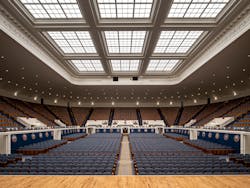CASE STUDY | Reimagining a historic laylight at DAR Constitution Hall
Prior to the COVID pandemic, anyone gazing at the ceiling of the historic Constitution Hall at the National Society of the Daughters of the American Revolution (DAR) headquarters, in Washington, D.C., might believe the 12 grand coffers were always filled with solid panels. Instead, the grid of mullions and muntins dividing each coffer into 81 panes were the remnants of a majestic glass laylight over the 3,702-seat concert hall, designed by architect John Russell Pope. At day, natural light from a skylight above would filter through the laylight and fill the hall; at night, the stars would reveal themselves. This centerpiece would be closed off and roofed over in the 1950s.
As part of a multiyear, multiphase renovation, local architecture firm Quinn Evans modernized Constitution Hall’s performance and support spaces to accommodate more event formats while preserving and restoring historic details, including the effect of the laylight. Project manager and Quinn Evans senior associate Katie Irwin says DAR members wanted “to restore Constitution Hall back to having its original appearance of daylight” and to experience gathering at their annual Continental Congress under the stars.
The challenge of achieving a daylight-filled environment with a decidedly closed-off ceiling would be softened only slightly by Quinn Evan’s prior experience of restoring a leaded glass laylight ceiling at DAR’s adjoining Memorial Continental Hall. At Constitution Hall, however, the 2014 installation of a roof-mounted photovoltaic array atop its former skylight precluded the restoration of its original skylight and laylight. Instead the design team, including the Chicago office of lighting design firm Schuler Shook and the local office of Loring Consulting Engineers, would have to re-create the effect.
Diffused daylight could be achieved through many available LED panel products; ensuring a uniform light distribution across the 24-inch-by-25.25-inch modules of the existing grid would be straightforward with today’s solid-state lighting technology. But creating a twinkling, star-filled night sky would require more thought. The team considered several options, such as the installation of video panels that would turn the ceiling into an array of downward-facing display screens. But the idea “was discarded pretty quickly due to cost concerns,” said John Jacobsen, senior lighting designer at Schuler Shook.
An idea emerged that would leverage a common complaint of older SSL products: the ability to see hot spots, or individual diodes, piercing through a diffuse layer. What if each illuminated star was an LED source exposed to view?
Jacobsen queried several manufacturers to gauge their interest in customizing a diffused light panel that combined point sources. In the end, Brescia, Italy–based Folio was “really excited about this,” says project architect and Quinn Evans associate Anne Kopf. The team worked through several mock-ups, experimenting with diode placement and integration to ensure the pin light appeared sharp and visible without creating defects in the surrounding diffuser.
Folio’s final iteration is a dual-mode product with tiny holes, 1/8 to 1/4 inch in diameter, drilled into the acrylic diffuser of its edge-lit Opal 3L panels to expose the star spotlight — from its Pico line — installed just behind the panel surface. “The hole is just big enough [to reveal] the diode,” Jacobsen says. The LEDs are by Nichia and have a minimum CRI of 90 and CRI R9 value of 50.
Of the 972 light panels, 60 have no stars to accommodate smoke detectors and sprinkler heads. These panels are also fixed in place, whereas the remaining panels can be removed by technical crews to facilitate the rigging of trusses, lighting, and equipment for the event below.
To enable portability, Folio also custom designed housings for each removable light panel that can “stand up to the rigors of being thrown around by the rigging staff,” Jacobsen adds. Panel connectors allow for easy plugging, unplugging, and bypassing so that the ceiling effectively becomes a grid of plug-and-play light modules.
Both the panels and the point sources can smoothly dim to 1% or lower. “We worked with the manufacturer to dial in on the appropriate drive current that would give us good visibility, but maintain that dimming range,” Jacobsen says. The general lights and star points are DMX-dimmed using separate drivers, he adds, and “the driver for the star points is multichannel so that we can individually control the star points and get the twinkling effect through programming.”
Electronic Theatre Controls (ETC) products control the new lighting systems throughout Constitution Hall, including dressing rooms, support spaces, and the concert hall’s coved plaster ceiling, which feature recessed fixtures by USAI Lighting whose LED sources can rotate to aim straight down no matter the fixture orientation.
An ETC Paradigm architectural processor controls day-to-day lighting scenarios through a touch screen station backstage and preset button stations at select room entrances. For events, crews can connect theatrical lighting consoles through an input panel in the backstage area. Jacobsen added that the starlight twinkling effect can be called either through the architectural processor or through programming sequences in the theatrical lighting console.
Project lighting credits
Primary lighting manufacturer: Folio
Lighting manufacturers: USAI (recessed downlights), Lucifer Lighting (vomitory steplights), Rejuvenation (sconces)
Lighting controls: Electronic Theatre Controls (manufacturer), Barbizon (dealer / integrator)
This piece was originally published by Architectural SSL, an Endeavor Business Media publication. Get the full story at Architectural SSL.
WANDA LAU is editorial director of LEDs Magazine, Smart Buildings Technology, and Architectural SSL. She previously served as executive editor of Architect magazine and worked for a decade in the architecture, engineering, and construction industry.
For up-to-the-minute LED and SSL updates, follow us on Twitter. You’ll find curated content and commentary, as well as information on industry events, webcasts, and surveys on our LinkedIn page and our Facebook page.

Wanda Lau | Editorial director, LEDs Magazine, Architectural SSL, and Smart Buildings Technology
Wanda Lau is an award-winning editor, writer, and podcaster whose work appears in several publications, including Architectural Lighting and Architect, where she was most recently the executive editor. In 2021, she was named one of Folio: and AdMonsters' Top Women in Media, in the DEI Champions category. Along with working a decade in the architecture, engineering, and construction industry, she holds a B.S. in civil engineering from Michigan State University, an S.M. in building technology from MIT, and an M.A. in journalism from Syracuse University.





